The Center Cannot Hold!
Q: What are the strategic
and tactical ideas behind white's hypermodern openings such as the
English, the Catalan, or the Reti? I've been trying to familiarize
myself with these openings, but once I leave the book I realize
that I don't understand what's going on. How do I use my fianchettoed
bishops? Where are whites pawn breaks? How do I undermine black's
center? – carbogens, in
this message board thread
A: First things first. Throw the
"book" out! Well, at least put it back on the shelf
for a while. Your negative experience is a great illustration of
the problem with playing book lines instead of moves you understand.
If you don't know why you are making EVERY move something is terribly
wrong.
 The
main reason we always recommend White Belts play classically (1.e4
or 1.d4 with pawn play in the center) is because classical play
is easier to understand and by no means weaker. Open lines for your
pieces and unblocked pawn centers are the best way to learn tactics
and piece play, the absolutely essential things to learn first. The
main reason we always recommend White Belts play classically (1.e4
or 1.d4 with pawn play in the center) is because classical play
is easier to understand and by no means weaker. Open lines for your
pieces and unblocked pawn centers are the best way to learn tactics
and piece play, the absolutely essential things to learn first.
Closed openings and hypermodern positions can require a lot of
knowledge and experience. Starting with them before your tactics
and other basics are competent is just asking for buckets of pain
and suffering. This is usually because the disadvantages of those
positions are a lot easier for your opponent to understand than
the advantages are for you to understand! (E.g. it's a lot easier
to play with space than without it.)
Hypermodern openings are what we call just about anything that
does not try to occupy the center with pawns (which is what we usually
call classical play). They even encourage the other side to take
over the center with a big pawn mass that can then be attacked from
the sides by pieces and wing pawns.
When players like Reti, Nimzowitsch, and Alekhine started playing
these provocative openings in the early 1900's their moves were
called bizarre and ugly by most of the leading voices of the day.
This is similar to how many of the gambiteers of the mid-19th century
criticized the closed openings like the French and Caro-Kann as
cowardly.
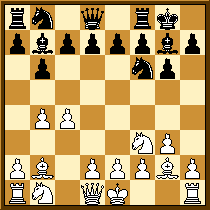 It
didn't take long for everyone to realize that these new systems
were not just a passing fad. Richard Reti's defeat of the "invincible"
world champion Capablanca at New York, 1924 was the final confirmation,
and not just because Reti won. It
didn't take long for everyone to realize that these new systems
were not just a passing fad. Richard Reti's defeat of the "invincible"
world champion Capablanca at New York, 1924 was the final confirmation,
and not just because Reti won.
Reti used his system in that game, which started 1.Nf3 Nf6 2.c4
g6 3.b4 Bg7 4.Bb2 0-0 5.g3 b6 6.Bg2 Bb7 (Diagram). By
1924 the great classical master Capa had long recognized the power
of these systems and he also fianchettoed both of his bishops! (A
fianchetto is playing g3 and Bg2, for example.)
Hypermodernism is a strategic concept, not a tactical one, and
you cannot talk of tactical themes that span the category. Positional
themes abound, however, and here are some of the critical ones to
keep in mind. Note that these are general guidelines, not commandments
never to be violated. Remember also that the true concept of hypermodernism,
according to one of its inventors, Reti, is the avoidance of routine
play. Think about each move and each move of your opponent.
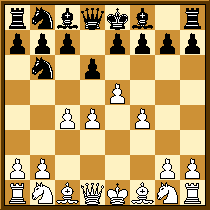 Right:
The Four Pawns Attack against Alekhine's Defense after 1.e4 Nf6
2.e5 Nd5 3.c4 Nb6 4.d4 d6 5.f4. Which side would you prefer to play?
Few Grandmasters play the Alekhine's these days with black, but
even fewer answer it with this giant center. Most play relatively
conservatively with 3.d4, proving that Black's provocative first
move has no direct refutation. Right:
The Four Pawns Attack against Alekhine's Defense after 1.e4 Nf6
2.e5 Nd5 3.c4 Nb6 4.d4 d6 5.f4. Which side would you prefer to play?
Few Grandmasters play the Alekhine's these days with black, but
even fewer answer it with this giant center. Most play relatively
conservatively with 3.d4, proving that Black's provocative first
move has no direct refutation.
1) Not occupying the center does not mean ignoring the center.
Just because you leave your d and e-pawns at home, or just move
them one square, does not mean you play only on the flanks. You
must still attack the center and attempt to control it from a distance.
The c-pawn, and sometimes the f-pawn, can attack the enemy center
pawns. Fianchettoed bishops cross the center squares. The center
is still the critical field of battle.
You can't let your opponent keep his big pawn center, especially
if it's mobile. It's imperative to attack it and/or stop it before
it crushes you. Hitting it with flank pawns isn't very effective
if the center pawns can pass by and just become even more dangerous.
2) You can't win a game from a distance and hypermodern play
is not passive or defensive play. It's one thing to allow your
opponent a big pawn center, it's another thing to let it roll over
your position like a wave. You have to fight back aggressively,
hitting the center and grabbing space on the flanks. This can mean
a strike with a center pawn when the moment is right. Not moving
them on move one doesn't mean they are glued to the board.
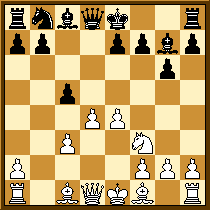 Left:
The Exchange Variation of the Grunfeld Defense. Black counterattacks
the massive white center with ...c5. The a2 pawn is weak but the
white center pawns can roll down the board. One of the sharpest
openings in modern play. Left:
The Exchange Variation of the Grunfeld Defense. Black counterattacks
the massive white center with ...c5. The a2 pawn is weak but the
white center pawns can roll down the board. One of the sharpest
openings in modern play.
3) Use your pawns to help your pieces and give them life.
This is always necessary but in hypermodern openings it is more
subtle and more important. A bishop on g2 doesn't look very good
if Black has pawns on c6 and d5, right? But if White can hammer
at d5 with c4 and open the c-file to hit the c6 pawn, the bishop
on g2 can be opened up.
The symbiotic relationship between the c4 pawn and a bishop on
g2 (or the c5 pawn and a g7 bishop for Black) is the clearest example.
You have to keep that long diagonal under pressure.
This goes double for your own pawns. You don't put a bishop on
g2 and then plunk a pawn on e4 to block its diagonal unless you
are sure you can open it back up. The tricky relationship between
pieces and pawns in hypermodern openings is the main reason they
aren't right for White Belts. You need to learn how to play with
your pieces before learning how to play without them in closed positions!
4) The idea is to build pressure. Keep aiming your pieces
at the center, looking for weak spots and trying to force their
creation. Don't release the tension with early exchanges or it will
decrease the number of potential weaknesses and make it easier for
your opponent to defend.
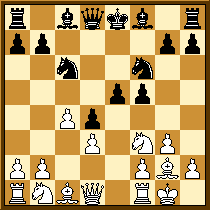 Right:
Black grabbed space but fell way behind in development in the process.
White was winning after 1.Nxe5! Nxe5 2.Re1, soon regaining the pieces
with an attack. (Lazic-Di Lazzaro in the file.) Right:
Black grabbed space but fell way behind in development in the process.
White was winning after 1.Nxe5! Nxe5 2.Re1, soon regaining the pieces
with an attack. (Lazic-Di Lazzaro in the file.)
5) Damaging your opponent's pawns is as important as forcing
them forward or winning them. Doubled pawns and isolated pawns
are vulnerable to attack and create more holes in a position that
pieces can take advantage of. Look for opportunities to force your
opponent to ruin his structure, creating weaknesses you can then
attack.
6) Hypermodern development, particularly the bishop fianchetto,
is slower than classical development. This can lead to major
disasters and very short games against an aggressive opponent aiming
at your king. The idea is to build pressure and plan breaks like
a diamond cutter. You can't continue such slow play against a direct
attack.
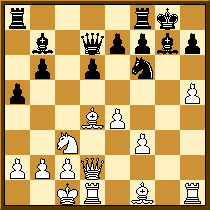 Left:
Instead of attacking the white king, Black played ..b6 and ..Bb7,
a very slow plan in a very sharp position. White used that extra
time to quickly break through on the kingside. Black resigned after
1.h6 Bg7 2.Qg5+ with mate on the next move. Left:
Instead of attacking the white king, Black played ..b6 and ..Bb7,
a very slow plan in a very sharp position. White used that extra
time to quickly break through on the kingside. Black resigned after
1.h6 Bg7 2.Qg5+ with mate on the next move.
That's exactly what we recommend when someone plays this way against
you. The margin for error is much smaller for the hypermodern player
so throw those pawns out there, open files, and blow them off the
board. As you and your opponents improve you'll learn to be more
cautious, but White Belts should be attacking directly until they
drop!
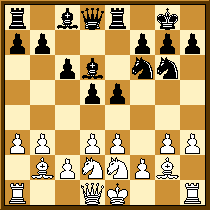 Right:
This oddly symmetrical position might look like a little joke by
White, but Black, a 2400-rated player, was completely lost by move
25 without making a serious blunder. (Blatny-Heberla in the file.)
White began to break down the center with the typical c4 and b4
plan to empower the g2 bishop. Right:
This oddly symmetrical position might look like a little joke by
White, but Black, a 2400-rated player, was completely lost by move
25 without making a serious blunder. (Blatny-Heberla in the file.)
White began to break down the center with the typical c4 and b4
plan to empower the g2 bishop.
7) A precautionary note to #6. White is still White! Just
because these moves aren't as overtly aggressive and leave the pieces
far away doesn't mean White has relinquished the advantage of the
first move by playing in hypermodern style. If Black ignores his
own development he can get killed almost as quickly as in an open
game.
|